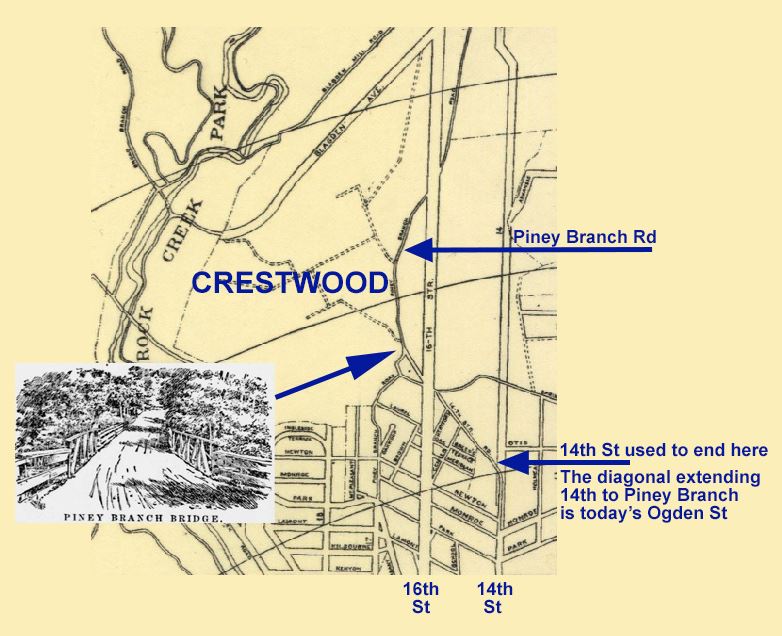By David Swerdloff

110 years ago this month, the Washington Post reported the completion of a marvel of engineering.
Today we’d call the article fake news: the project had actually become a boondoggle.
But its story is noteworthy because eventually it became the spark that transformed our neighborhood from a sleepy estate into a community of homes.
The undertaking was the construction of the Sixteenth Street “Tiger” Bridge.
Look at the bridge with new eyes: it extends over a deep chasm cut through the centuries by the Piney Branch (at one time an extensive network of creeks, springs and streams). The span was the first parabolic arch bridge in the United States, and mayhave been the longest in the world.
What the article failed to mention is that Congress hadn’t appropriated the money to build the entire bridge. Instead, funding was released for just one narrow span, which was finished in 1907 (though in December, not August). Two DC Commissioners and the House Appropriations Committee Chairman took a celebratory drive across it. Then nothing happened for nearly two years. As the Post commented in 1909, the one span simply “stood like a big white monument in the surrounding woods.”
Lawmakers got around to funding a second span and the union of the two sections to create the bridge we see today. It opened in 1910, taking Sixteenth Street north…though not far. The road had not even been paved up to Military Road. The finishing touch in 1911 was the installation of four tiger sculptures cast in bronze, weighing 1,550 pounds apiece.
Before 1910, our neighborhood had been a hard slog to get to. The bridge and the extension of Sixteenth Street replaced a rustic country road. Piney Branch Road had been the only roadway in our area as it moseyed from Mount Pleasant to Brightwood.
Its crude wooden bridge across the Piney Branch was passable for pedestrians, but horses and carriages were well advised to use the nearby ford. A steep slope wound down from Mount Pleasant on the south side, with forbidding Blagden’s Hill facing travelers on the north.
We can see vestiges of the old route along 17th Street in Mount Pleasant as it plunges today toward Piney Branch Parkway. On the north side of the creek, the roadway ascended into our neighborhood, passing behind what is now the Crestwood Apartments. Though that part of its path is green space today, it’s still listed as an official DC right-of- way from the water’s edge up to Shepherd Street. Piney Branch Road then continued north northeast from the present-day intersection of 17th and Shepherd, crossing what is now Sixteenth Street just above Webster. The old road endures north of Buchanan Street, and a stroll along those narrow blocks feels like a step back in time.
Piney Branch Road also formed the eastern boundary of the Blagden family’s Argyle estate. The 300-acre property, first mapped nearly 300 years ago, still largely defines the boundaries of Crestwood. The estate was centered on an 1840s mansion located on (as the 1910 Census put it): “no street—house is back in woods—enter from Piney Branch Rd.” The home would sit today near the corner of 18 th and Varnum, had it not been razed in 1934. The two oldest houses still standing in Crestwood were built along Piney Branch Road, although both of these 1900 wood-frame structures now have Upshur Street addresses.
Merely having a plan to forgo the old route by constructing a modern bridge was enough to jump-start the sale of building lots in Crestwood (then called the Blagden Subdivision). Advertising appeared for new developments named “Mount Pleasant Heights” (1904) and “Argyle Park” (1907). Several older houses were torn down to prepare lots for development, including a number of small rental properties where African American day laborers lived with their families.
New houses began appearing on the lots as the bridge was being finished in 1910. They were erected mainly in the north end of the neighborhood to take advantage of Decatur Street, the only road that provided access east to the 14th Street streetcar line (opened in 1906).
Builders and buyers realized the new Sixteenth Street would provide a prestige address. “The absence of street cars on this fine thoroughfare and the high character of the surroundings insure the early establishment of one of the finest boulevards in the country,” reported the Post in 1907. “A movement is already on foot to have this driveway designated ‘The Avenue of the Presidents.’”
More than a century later, Sixteenth Street remains a grand entrance to Crestwood. And the bridge not completed in August 1907 was the marvel that made our community possible.